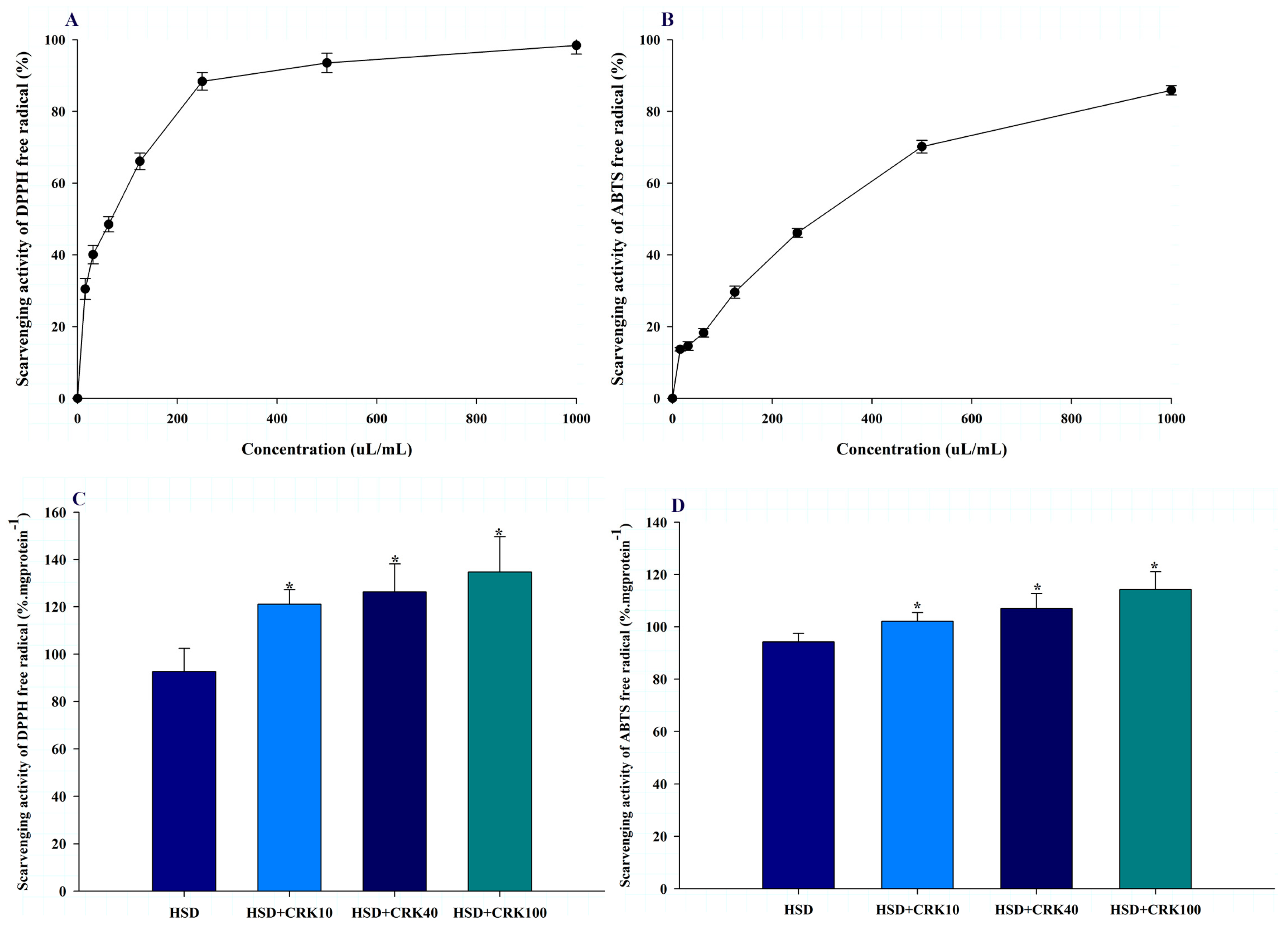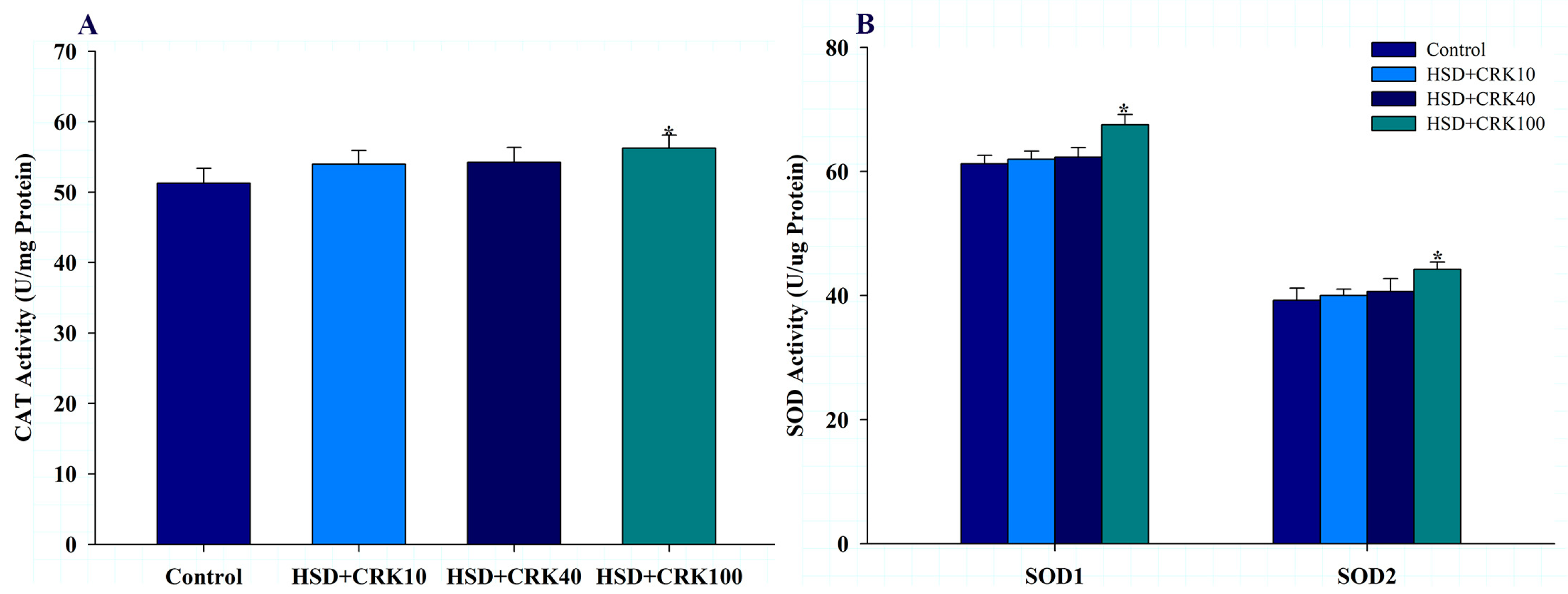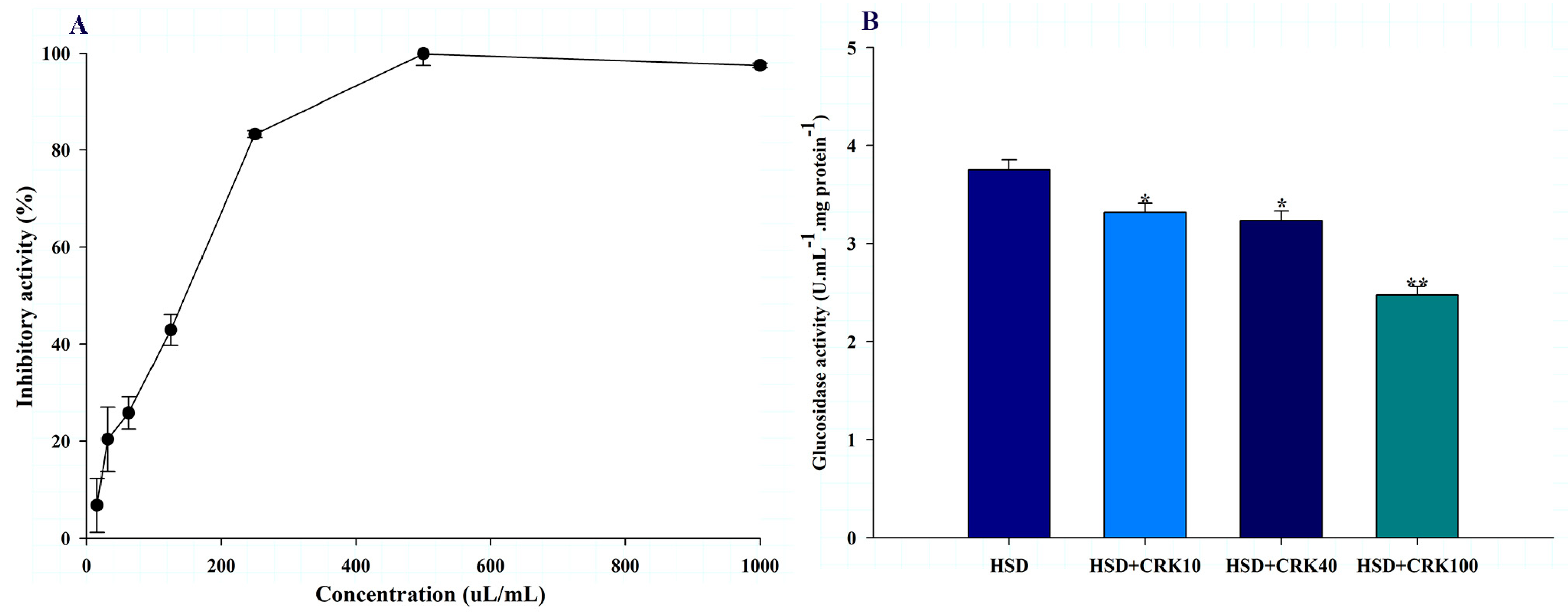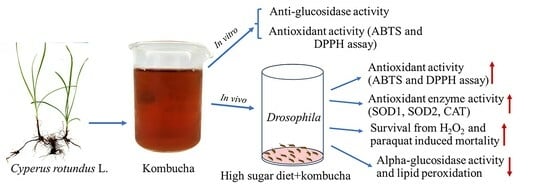In Vitro and In Vivo Evaluation for Antioxidant and Anti-Diabetic Properties of Cyperus rotundus L. Kombucha
Abstract
:1. Introduction
2. Materials and Methods
2.1. Chemicals
2.2. Plant Materials and Preparation of Kombucha
2.3. GC-MS Analysis of C. rotundus Kombucha
2.4. HPLC Analysis of C. rotundus Kombucha
2.5. In Vitro Antioxidant Activity
2.5.1. Scavenging DPPH Free Radical Activity Assay
2.5.2. Scavenging ABTS Free Radical Activity Assay
2.6. In Vitro Anti-Alpha Glucosidase Activity
2.7. Drosophila Strain, Culture Conditions, and Experimental Design
2.8. In Vivo Antioxidant Activity
2.8.1. Scavenging DPPH Free Radical Activity Assay
2.8.2. Scavenging ABTS Free Radical Activity Assay
2.8.3. SOD Activity
2.8.4. CAT Activity
2.8.5. Measurement of Lipid Peroxidation
2.8.6. H2O2 and Paraquat Challenge Tests
2.9. In Vivo Anti-Alpha Glucosidase Activity
2.10. Protein Content Assay
2.11. Statistical Analysis
3. Results
3.1. Chemical Profiles of C. rotundus Kombucha
3.2. Effects of C. rotundus Kombucha on In Vitro and In Vivo Antioxidant Activity
3.3. Effects of C. rotundus Kombucha on In Vitro and In Vivo Alpha-Glucosidase Inhibitory Activity
4. Discussion
5. Conclusions
Author Contributions
Funding
Institutional Review Board Statement
Data Availability Statement
Acknowledgments
Conflicts of Interest
References
- Pirzada, A.M.; Ali, H.H.; Naeem, M.; Latif, M.; Bukhari, A.H.; Tanveer, A. Cyperus rotundus L.: Traditional uses, phytochemistry, and pharmacological activities. J. Ethnopharmacol. 2015, 174, 540–560. [Google Scholar] [CrossRef] [PubMed]
- Yazdanparast, R.; Ardestani, A. In vitro antioxidant and free radical scavenging activity of Cyperus rotundus. J. Med. Food 2007, 10, 667–674. [Google Scholar] [CrossRef] [PubMed]
- Hema, N.; Avadhani, R.; Ravishankar, B.; Anupama, N. A comparative analysis of antioxidant potentials of aqueous and ethanolic extracts of Cyperus rotundus (L.). Asian. J. Biomed. Pharm. Sci. 2013, 3, 7–11. [Google Scholar]
- Hu, Q.P.; Cao, X.M.; Hao, D.L.; Zhang, L.L. Chemical composition, antioxidant, DNA damage protective, cytotoxic and antibacterial activities of Cyperus rotundus rhizomes essential oil against foodborne pathogens. Sci. Rep. 2017, 7, 45231. [Google Scholar] [CrossRef] [PubMed]
- Raut, N.A.; Gaikwad, N.J. Antidiabetic activity of hydro-ethanolic extract of Cyperus rotundus in alloxan induced diabetes in rats. Fitoterapia 2006, 77, 585–588. [Google Scholar] [CrossRef] [PubMed]
- Tran, H.H.; Nguyen, M.C.; Le, H.T.; Nguyen, T.L.; Pham, T.B.; Chau, V.M.; Nguyen, H.N.; Nguyen, T.D. Inhibitors of α-glucosidase and α-amylase from Cyperus rotundus. Pharm. Biol. 2014, 52, 74–77. [Google Scholar] [CrossRef]
- Athesh, K.; Divakar, M.; Brindha, P. Anti-obesity potential of Cyperus rotundus L. aqueous tuber extract in rats fed on high fat cafeteria diet. Asian. J. Pharm. Clin. Res. 2014, 7, 88–92. [Google Scholar]
- Jin, J.H.; Lee, D.U.; Kim, Y.S.; Kim, H.P. Anti-allergic activity of sesquiterpenes from the rhizomes of Cyperus rotundus. Arch. Pharm. Res. 2011, 34, 223–228. [Google Scholar] [CrossRef]
- Aeganathan, R.; Rayar, A.; Ilayaraja, S.; Prabakaran, K.; Manivannan, R. Anti-oxidant, antimicrobial evaluation and GC-MS analysis of Cyperus rotundus L. rhizomes chloroform fraction. Am. J. Ethnomedicine 2015, 2, 14–20. [Google Scholar]
- Daswani, P.G.; Brijesh, S.; Tetali, P.; Birdi, T.J. Studies on the activity of Cyperus rotundus Linn. tubers against infectious diarrhea. Indian. J. Pharmacol. 2011, 43, 340. [Google Scholar]
- Nazish, J.; Shoukat, A. Cardioprotective and antilipidemic potential of Cyperus rotundus in chemically induced cardiotoxicity. Int. J. Agric. Biol. 2012, 14, 989–992. [Google Scholar]
- Güldür, M.E.; Ozgönül, A.; Kilic, I.H.; Sögüt, O.; Ozaslan, M.; Bitiren, M.; Yalcin, M.; Musa, D. Gastroprotective effect of Cyperus rotundus extract against gastric mucosal injury induced by ischemia and reperfusion in rats. IJP-Int. J. Pharmacol. 2010, 6, 104–110. [Google Scholar] [CrossRef]
- Parvez, M.K.; Al-Dosari, M.S.; Arbab, A.H.; Niyazi, S. The in vitro and in vivo anti-hepatotoxic, anti-hepatitis B virus and hepatic CYP450 modulating potential of Cyperus rotundus. Saudi. Pharm. J. 2019, 27, 558–564. [Google Scholar] [CrossRef]
- Soumaya, K.J.; Dhekra, M.; Fadwa, C.; Zied, G.; Ilef, L.; Kamel, G.; Leila, C.G. Pharmacological, antioxidant, genotoxic studies and modulation of rat splenocyte functions by Cyperus rotundus extracts. BMC Complement. Altern. Med. 2013, 13, 28. [Google Scholar]
- Mehdizadeh, M.; Hashem Dabaghian, F.; Shojaee, A.; Molavi, N.; Taslimi, Z.; Shabani, R.; Soleimani Asl, S. Protective effects of Cyperus rotundus extract on amyloid β-peptide (1-40)-induced memory impairment in male rats: A behavioral study. Basic Clin. Neurosci. 2017, 8, 249. [Google Scholar] [CrossRef]
- Sutalangka, C.; Wattanathorn, J. Neuroprotective and cognitive-enhancing effects of the combined extract of Cyperus rotundus and Zingiber officinale. BMC Complement. Altern. Med. 2017, 17, 135. [Google Scholar] [CrossRef]
- Simorangkir, D.; Masfria, M.; Harahap, U.; Satria, D. Activity anticancer n-hexane fraction of Cyperus rotundus L. Rhizome to breast cancer MCF-7 cell line. Open Access Maced. J. Med. Sci. 2019, 7, 3904. [Google Scholar] [CrossRef]
- Biradar, S.; Kangralkar, V.A.; Mandavkar, Y.; Thakur, M.; Chougule, N. Antiinflammatory, antiarthritic, analgesic and anticonvulsant activity of Cyperus essential oils. Int. J. Pharm. Pharm. Sci. 2010, 2, 112–115. [Google Scholar]
- Tsoyi, K.; Jang, H.J.; Lee, Y.S.; Kim, Y.M.; Kim, H.J.; Seo, H.G.; Lee, J.H.; Kwak, J.H.; Lee, D.U.; Chang, K.C. (+)-Nootkatone and (+)-valencene from rhizomes of Cyperus rotundus increase survival rates in septic mice due to heme oxygenase-1 induction. J. Ethnopharmacol. 2011, 137, 1311–1317. [Google Scholar] [CrossRef]
- Rocha, F.G.; Brandenburg, M.M.; Pawloski, P.L.; Soley, B.D.S.; Costa, S.C.A.; Meinerz, C.C.; Baretta, I.P.; Otuki, M.F.; Cabrini, D.A. Preclinical study of the topical anti-inflammatory activity of Cyperus rotundus L. extract (Cyperaceae) in models of skin inflammation. J. Ethnopharmacol. 2020, 254, 112709. [Google Scholar] [CrossRef]
- Sharma, A.; Verma, R.; Ramteke, P. Cyperus rotundus: A potential novel source of therapeutic compound against urinary tract pathogens. J. Herb. Med. 2014, 4, 74–82. [Google Scholar] [CrossRef]
- Shivakumar, S.I.; Suresh, H.M.; Hallikeri, C.S.; Hatapakki, B.C.; Handiganur, J.S.; Kuber, S.; Shivakumar, B. Anticonvulsant effect of Cyperus rotundus Linn rhizomes in rats. J. Nat. Remedies 2009, 9, 192–196. [Google Scholar]
- Zhou, Z.L.; Yin, W.Q.; Yang, Y.M.; He, C.H.; Li, X.N.; Zhou, C.P.; Guo, H. New iridoid glycosides with antidepressant activity isolated from Cyperus rotundus. Chem. Pharm. Bull. 2016, 64, 73–77. [Google Scholar] [CrossRef] [PubMed]
- Wongchum, N.; Dechakhamphu, A.; Chaweerak, S.; Pinlaor, S.; Tanomtong, A. Evaluation of aqueous and ethanol extracts of Cyperus rotundus L. on sexual behaviours and reproductive fitness in Drosophila melanogaster. Pharm. Sci. Asia 2021, 48, 516–522. [Google Scholar]
- Wongchum, N.; Dechakhamphu, A.; Ma-ding, A.; Khamphaeng, T.; Pinlaor, S.; Pinmongkhonkul, S.; Tanomtong, A. The effects of Cyperus rotundus L. extracts on the longevity of Drosophila melanogaster. S. Afr. J. Bot. 2022, 148, 218–227. [Google Scholar] [CrossRef]
- Wongchum, N.; Dechakhamphu, A.; Panya, P.; Pinlaor, S.; Pinmongkhonkul, S.; Tanomtong, A. Hydroethanolic Cyperus rotundus L. extract exhibits anti-obesity property and increases lifespan expectancy in Drosophila melanogaster fed a high-fat diet. J. Herbmed. Pharmacol. 2022, 11, 296–304. [Google Scholar] [CrossRef]
- Hossain, U.; Das, A.K.; Ghosh, S.; Sil, P.C. An overview on the role of bioactive α-glucosidase inhibitors in ameliorating diabetic complications. Food Chem. Toxicol. 2020, 145, 111738. [Google Scholar] [CrossRef]
- Ghani, U. Re-exploring promising α-glucosidase inhibitors for potential development into oral anti-diabetic drugs: Finding needle in the haystack. Eur. J. Med. Chem. 2015, 103, 133–162. [Google Scholar] [CrossRef]
- Apovian, C.M.; Okemah, J.; O’Neil, P.M. Body weight considerations in the management of type 2 diabetes. Adv. Ther. 2019, 36, 44–58. [Google Scholar] [CrossRef]
- da Silva Júnior, J.C.; Mafaldo, Í.M.; de Lima Brito, I.; de Magalhães Cordeiro, A.M.T. Kombucha: Formulation, chemical composition, and therapeutic potentialities. Curr. Res. Food. Sci. 2022, 5, 360–365. [Google Scholar] [CrossRef]
- Morales, D. Biological activities of kombucha beverages: The need of clinical evidence. Trends. Food. Sci. Technol. 2020, 105, 323–333. [Google Scholar] [CrossRef]
- Palanker Musselman, L.; Fink, J.L.; Narzinski, K.; Ramachandran, P.V.; Sukumar Hathiramani, S.; Cagan, R.L.; Baranski, T.J. A high-sugar diet produces obesity and insulin resistance in wild-type Drosophila. Dis. Model. Mech. 2011, 4, 842–849. [Google Scholar] [CrossRef] [PubMed]
- Partridge, L.; Alic, N.; Bjedov, I.; Piper, M.D. Ageing in Drosophila: The role of the insulin/Igf and TOR signalling network. Exp. Gerontol. 2011, 46, 376–381. [Google Scholar] [CrossRef] [PubMed]
- Morris, S.N.S.; Coogan, C.; Chamseddin, K.; Fernandez-Kim, S.O.; Kolli, S.; Keller, J.N.; Bauer, J.H. Development of diet-induced insulin resistance in adult Drosophila melanogaster. Biochim. Biophys. Acta. BBA-Mol. Basis. Dis. 2012, 1822, 1230–1237. [Google Scholar] [CrossRef]
- Na, J.; Musselman, L.P.; Pendse, J.; Baranski, T.J.; Bodmer, R.; Ocorr, K.; Cagan, R. A Drosophila model of high sugar diet-induced cardiomyopathy. PLoS Genet. 2013, 9, e1003175. [Google Scholar] [CrossRef]
- Tanimura, T.; Kitamura, K.; Fukuda, T.; Kikuchi, T. Purification and partial characterization of three forms of α-glucosidase from the fruit fly Drosophila melanogaster. J. Biochem. 1979, 85, 123–130. [Google Scholar] [CrossRef]
- Pistia-Brueggeman, G.; Hollingsworth, R.I. A preparation and screening strategy for glycosidase inhibitors. Tetrahedron 2001, 57, 8773–8778. [Google Scholar] [CrossRef]
- Zeb, A.; Ullah, F. A simple spectrophotometric method for the determination of thiobarbituric acid reactive substances in fried fast foods. J. Anal. Methods Chem. 2016, 2016, 9412767. [Google Scholar] [CrossRef]
- Gerritsen, G.C.; Dulin, W.E. Effect of a new hypoglycemic agent, 3, 5-dimethylpyrazole, on carbohydrate and free fatty acid metabolism. Diabetes 1965, 14, 507–515. [Google Scholar] [CrossRef]
- Cavallini, G.; Donati, A.; Bergamini, E. Antiaging Therapy: A Novel Target for Antilipolytic Drugs. Mini-Rev. Med. Chem. 2014, 14, 551–556. [Google Scholar] [CrossRef]
- Chukwu, C.; Omaka, O.; Aja, P. Characterization of 2, 5-dimethyl-2, 4-dihydroxy-3 (2H) furanone, a flavourant principle from Sysepalum dulcificum. Nat. Prod. Chem. Res. 2017, 5, 2. [Google Scholar]
- Dilek Tepe, H.; Doyuk, F. Determination of phytochemical content by chromatographic methods and antioxidant capacity in methanolic extract of jujube (Zizyphus jujuba Mill.) and oleaster (Elaeagnus a ngustifolia L.). Int. J. Fruit. Sci. 2020, 20, S1876–S1890. [Google Scholar] [CrossRef]
- Priyaa, G.H.; More, S.S. Antioxidant, anti-proliferative, and anti-atherosclerotic effect of phytochemicals isolated from Trachyspermum ammi with honey in RAW 264.7 and THP-1 cells. Pharmacogn. Mag. 2022, 18, 143–151. [Google Scholar]
- Joel, O.O.; Maharjan, R. Effects of 5-hydroxymethylfurfural isolated from Cola hispida on oral adenosquamous carcinoma and MDR Staphylococcus aureus. JMPHTR 2021, 8, 1–7. [Google Scholar]
- Doughari, J.H.; Abraham, M. Antifungal activity of Jatropha Curcas Linn on Candida albicans and Candida tropicalis associated with neonatal and infantile infections in Yola, Nigeria. Am. J. Agric. Biol. Sci. 2021, 16, 19–32. [Google Scholar] [CrossRef]
- Shobana, S.; Vidhya, V.; Ramya, M. Antibacterial activity of garlic varieties (ophioscordon and sativum) on enteric pathogens. Curr. Res. J. Biol. Sci. 2009, 1, 123–126. [Google Scholar]
- Van Chen, T.; Cuong, T.D.; Quy, P.T.; Bui, T.Q.; Van Tuan, L.; Van Hue, N.; Triet, N.T.; Ho, D.V.; Bao, N.C.; Nhung, N.T.A. Antioxidant activity and α-glucosidase inhibitability of Distichochlamys citrea MF Newman rhizome fractionated extracts: In vitro and in silico screenings. Chem. Pap. 2022, 76, 5655–5675. [Google Scholar] [CrossRef]
- Kakarla, L. Comparative Biochemical Studies on Indian Sedges Cyperus scariosus R Br and Cyperus rotundus L. Pharmacogn. J. 2017, 8, 598–609. [Google Scholar] [CrossRef]
- Huang, X.; Li, J.; Hong, Y.; Jiang, C.; Wu, J.; Wu, M.; Sheng, R.; Liu, H.; Sun, J.; Xin, Y.; et al. Antiviral effects of the petroleum ether extract of Tournefortia sibirica L. against enterovirus 71 infection in vitro and in vivo. Front. Pharmacol. 2022, 13, 999798. [Google Scholar] [CrossRef]
- Gabay, O.; Sanchez, C.; Salvat, C.; Chevy, F.; Breton, M.; Nourissat, G.; Wolf, C.; Jacques, C.; Berenbaum, F. Stigmasterol: A phytosterol with potential anti-osteoarthritic properties. Osteoarthritis. Cartil. 2010, 18, 106–116. [Google Scholar] [CrossRef]
- Chandler, R.F.; Hooper, S.N.; Ismail, H.A. Antihypercholesterolemic studies with sterols: Beta-sitosterol and stigmasterol. J. Pharm. Sci. 1979, 68, 245–247. [Google Scholar] [CrossRef] [PubMed]
- Batta, A.K.; Xu, G.; Honda, A.; Miyazaki, T.; Salen, G. Stigmasterol reduces plasma cholesterol levels and inhibits hepatic synthesis and intestinal absorption in the rat. Metabolism 2006, 55, 292–299. [Google Scholar] [CrossRef] [PubMed]
- Kasahara, Y.; Kumaki, K.; Katagiri, S.; Yasukawa, K.; Yamanouchi, S.; Takido, M.; Akihisa, T.; Tamura, T. Carthami flos extract and its component, stigmasterol, inhibit tumour promotion in mouse skin two-stage carcinogenesis. Phytother. Res. 1994, 8, 327–331. [Google Scholar] [CrossRef]
- Gao, Z.; Maloney, D.J.; Dedkova, L.M.; Hecht, S.M. Inhibitors of DNA polymerase β: Activity and mechanism. Bioorg. Med. Chem. 2008, 16, 4331–4340. [Google Scholar] [CrossRef] [PubMed]
- Panda, S.; Jafri, M.; Kar, A.; Meheta, B. Thyroid inhibitory, antiperoxidative and hypoglycemic effects of stigmasterol isolated from Butea monosperma. Fitoterapia 2009, 80, 123–126. [Google Scholar] [CrossRef]
- Lim, J.C.; Park, J.H.; Budesinsky, M.; Kasal, A.; Han, Y.H.; Koo, B.S.; Lee, S.I.; Lee, D.U. Antimutagenic constituents from the thorns of Gleditsia sinensis. Chem. Biol. Pharm. Bull. 2005, 53, 561–564. [Google Scholar] [CrossRef]
- Navarro, A.; De Las Heras, B.; Villar, A. Anti-inflammatory and immunomodulating properties of a sterol fraction from Sideritis foetens Clem. Biol. Pharm. Bull. 2001, 24, 470–473. [Google Scholar] [CrossRef]
- Garcia, M.; Saenz, M.; Gomez, M.; Fernández, M. Topical antiinflammatory activity of phytosterols isolated from Eryngium foetidum on chronic and acute inflammation models. Phytother. Res. Int. J. Devoted. Pharmacol. Toxicol. Eval. Nat. Prod. Deriv. 1999, 13, 78–80. [Google Scholar]
- Li, Y.M.; Chan, H.Y.E.; Huang, Y.; Chen, Z.Y. Green tea catechins upregulate superoxide dismutase and catalase in fruit flies. Mol. Nutr. Food. Res. 2007, 51, 546–554. [Google Scholar] [CrossRef]
- Singh, A.K.; Singla, R.K.; Pandey, A.K. Chlorogenic acid: A dietary phenolic acid with promising pharmacotherapeutic potential. Curr. Med. Chem. 2023, 30, 3905–3926. [Google Scholar] [CrossRef]
- Sheng, Y.; Sun, Y.; Tang, Y.; Yu, Y.; Wang, J.; Zheng, F.; Li, Y.; Sun, Y. Catechins: Protective mechanism of antioxidant stress in atherosclerosis. Front. Pharmacol. 2023, 14, 1144878. [Google Scholar] [CrossRef] [PubMed]
- Kashtoh, H.; Baek, K.H. Recent updates on phytoconstituent alpha-glucosidase inhibitors: An approach towards the treatment of type two diabetes. Plants 2022, 11, 2722. [Google Scholar] [CrossRef] [PubMed]
- Junejo, J.A.; Zaman, K.; Rudrapal, M.; Celik, I.; Attah, E.I. Antidiabetic bioactive compounds from Tetrastigma angustifolia (Roxb.) Deb and Oxalis debilis Kunth.: Validation of ethnomedicinal claim by in vitro and in silico studies. S. Afr. J. Bot. 2021, 143, 164–175. [Google Scholar] [CrossRef]
- Lolok, N.; Sumiwi, S.A.; Ramadhan, D.S.F.; Levita, J.; Sahidin, I. Molecular dynamics study of stigmasterol and beta-sitosterol of Morinda citrifolia L. towards α-amylase and α-glucosidase. J. Biomol. Struct. Dyn. 2023, 1–4. [Google Scholar] [CrossRef] [PubMed]
- Tasnuva, S.T.; Qamar, U.A.; Ghafoor, K.; Sahena, F.; Jahurul, M.H.A.; Rukshana, A.H.; Juliana, M.J.; Al-Juhaimi, F.Y.; Jalifah, L.; Jalal, K.C.A.; et al. α-glucosidase inhibitors isolated from Mimosa pudica L. Nat. Prod. Res. 2019, 33, 1495–1499. [Google Scholar] [CrossRef] [PubMed]
- Wang, S.; Li, Y.; Huang, D.; Chen, S.; Xia, Y.; Zhu, S. The inhibitory mechanism of chlorogenic acid and its acylated derivatives on α-amylase and α-glucosidase. Food Chem. 2022, 372, 131334. [Google Scholar] [CrossRef]





| No. | Name | Chemical Formula | RT | Previously Reported Biological Activity | Ref. |
|---|---|---|---|---|---|
| 1 | 3,5-Dimethylpyrazole | C5H8N2 | 3.712 | Hypoglycemic activity Anti-aging | [39,40] |
| 2 | Benzen-d5-amine | C6H2D5N | 4.008 | Not reported | NA |
| 3 | 5-.alpha.-Aminoethyltetrazole | C3H7N5 | 5.156 | Not reported | NA |
| 4 | 2,4-Dihydroxy-2,5-dimethyl-3(2H)-furan-3-one | C6H8O4 | 6.112 | Flavourant | [41] |
| 5 | Xylopyranoside, methyl-4-azido-4-deoxy-, .beta.-L | C6 H11N3O4 | 6.475 | Not reported | NA |
| 6 | Propylamine, N,N,2,2-tetramethyl-, N-oxide | C7H17N O | 6.992 | Not reported | NA |
| 7 | Furaneol | C6H8O3 | 7.546 | Not reported | NA |
| 8 | 4H-Pyran-4-one, 2,3-dihydro-3,5-dihydroxy-6-methyl | C6H8O4 | 9.535 | Antioxidant activity | [42] |
| 9 | Butyl-tert-butylisopropoxyborane | C11H25BO | 10.119 | Not reported | NA |
| 10 | 1-Tetrazol-2-ylethanone | C3H4N4O | 10.224 | Not reported | NA |
| 11 | 2-(4-Methyl-1H-1,2,3-triazol-1-yl)ethan-1-amine | C5H10N4 | 10.587 | Antioxidant, anti-proliferative, and anti-atherosclerotic activities | [43] |
| 12 | Lactic acid, 2-methyl-, monoanhydride with 1-butaneboronic acid, cyclic ester | C8H15BO3 | 10.606 | Not reported | NA |
| 13 | 1-Tetrazol-2-ylethanone | C3H4N4O | 10.903 | Not reported | NA |
| 14 | Borinic acid, diethyl- | C4H11BO | 10.684 | Not reported | NA |
| 15 | 5-Hydroxymethylfurfural | C6H6O3 | 11.294 | Anticancer activity | [44] |
| 16 | 10-Azido-1-decanethiol | C10H21N3S | 12.604 | Anti-fungal activity | [45] |
| 17 | .beta.-D-Glucosyloxyazoxymethane | C8H16N2O7 | 13.532 | Not reported | NA |
| 18 | Ethanone, 1,1’-(2-ethyl-4,5-dimethyl-1,3,2-dioxaborolane-4,5-diyl)bis | C10H17BO4 | 14.144 | Not reported | NA |
| 19 | 1,3,2-Dioxaborolane, 2-ethyl-4-(3-oxiranylpropyl)- | C9H17BO3 | 15.330 | Not reported | NA |
| 20 | Ethanone, 1-[5-(1,1-dimethylethyl)-2-ethyl-4-methyl-1,3,2-dioxaborolan-4-yl]- | C11H21BO3 | 18.036 | Not reported | NA |
| 21 | 3- Deoxy-D-mannoic lactone | C6H10O5 | 18.629 | Antibacterial activity Antioxidant and alpha-glucosidase inhibitor activities | [46,47] |
| 22 | 1-.beta.-d-Ribofuranosyl-3-[5-tetraazolyl]-1,2,4-triazole | C8H11N7O4 | 21.239 | Analgesics, antipyretics, anti-convulsants, anti-inflammatory, immune modulatory activity | [48] |
| 23 | Nona-2,3-dienoic acid, ethyl ester | C11H18O2 | 24.949 | Antiviral activity | [49] |
| 24 | Stigmasterol | C29H48O | 29.530 | Anti-osteoarthritic activity Anti-hypercholestrolemic activity Anti-tumor Antioxidant Antimutagenic activity Anti-inflammatory activity CNS activities | [50,51,52,53,54,55,56,57,58] |
Disclaimer/Publisher’s Note: The statements, opinions and data contained in all publications are solely those of the individual author(s) and contributor(s) and not of MDPI and/or the editor(s). MDPI and/or the editor(s) disclaim responsibility for any injury to people or property resulting from any ideas, methods, instructions or products referred to in the content. |
© 2023 by the authors. Licensee MDPI, Basel, Switzerland. This article is an open access article distributed under the terms and conditions of the Creative Commons Attribution (CC BY) license (https://creativecommons.org/licenses/by/4.0/).
Share and Cite
Dechakhamphu, A.; Wongchum, N.; Chumroenphat, T.; Tanomtong, A.; Pinlaor, S.; Siriamornpun, S. In Vitro and In Vivo Evaluation for Antioxidant and Anti-Diabetic Properties of Cyperus rotundus L. Kombucha. Foods 2023, 12, 4059. https://doi.org/10.3390/foods12224059
Dechakhamphu A, Wongchum N, Chumroenphat T, Tanomtong A, Pinlaor S, Siriamornpun S. In Vitro and In Vivo Evaluation for Antioxidant and Anti-Diabetic Properties of Cyperus rotundus L. Kombucha. Foods. 2023; 12(22):4059. https://doi.org/10.3390/foods12224059
Chicago/Turabian StyleDechakhamphu, Ananya, Nattapong Wongchum, Theeraphan Chumroenphat, Alongklod Tanomtong, Somchai Pinlaor, and Sirithon Siriamornpun. 2023. "In Vitro and In Vivo Evaluation for Antioxidant and Anti-Diabetic Properties of Cyperus rotundus L. Kombucha" Foods 12, no. 22: 4059. https://doi.org/10.3390/foods12224059
APA StyleDechakhamphu, A., Wongchum, N., Chumroenphat, T., Tanomtong, A., Pinlaor, S., & Siriamornpun, S. (2023). In Vitro and In Vivo Evaluation for Antioxidant and Anti-Diabetic Properties of Cyperus rotundus L. Kombucha. Foods, 12(22), 4059. https://doi.org/10.3390/foods12224059






